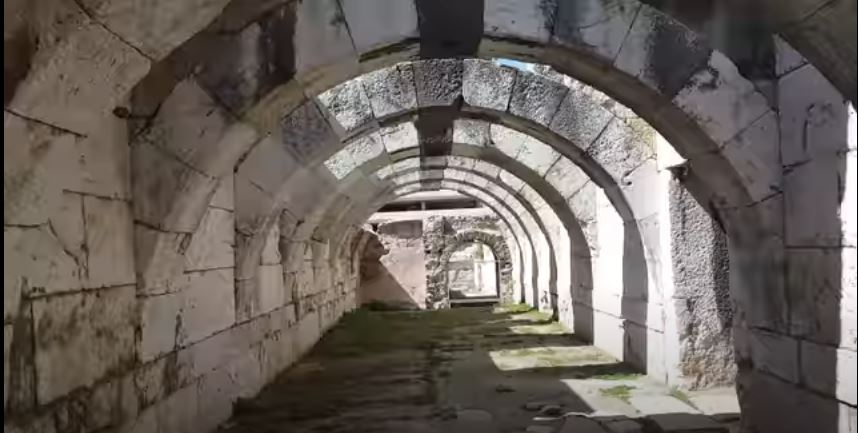Discover Ephesus and Top Destinations in Western Turkey with an expert tour guide and a TripAdvisor Winner for 13 consecutive years.
History of Ancient SmyrnaSmyrna, the ancient name of Izmir, holds a significant place in the history of modern Turkey. Situated 600km to the south of Istanbul, the country's largest city, Smyrna's origins can be traced back to the era of legendary Amazonian warrior women, much like other cities along the Aegean coastline. This fascinating heritage is a testament to the rich cultural tapestry of Turkey and the influence of powerful female figures throughout history. Today, Izmir stands as the third largest city in the country, offering a vibrant mix of tradition and modernity. With its awe-inspiring historical sites, bustling markets, and stunning coastal views, Smyrna, now known as Izmir, continues to captivate visitors and locals alike. According to some historians, the legendary city was believed to have been founded by the Phrygian King Tantalos and his family. One prominent figure in this fascinating tale was Tantalos' daughter, Niobe, who was said to have had the impressive number of seven sons and seven daughters. However, Niobe's abundance of children seemed to bring her great trouble. Leto, who could only boast of having two children, became envious and embarrassed by Niobe's impressive brood. In a tragic turn of events, the twins of Leto, Artemis and Apollo took action by brutally murdering all fourteen of Niobe's children. Overwhelmed with grief, Niobe sought solace on Mount Sipylus, where she too was turned to stone. Tantalus was a person who was very popular among the gods and won the admiration of the gods. But one day he decided to test their strength by inviting them to a lavish banquet. In a shocking display, Tantalus cooked and served his own son Pelops to the holy guests. Understandably horrified by this terrible act, the gods refrained from participating in the meal, except for Demeter, who was still grieving the loss of her daughter Persephone and succumbed to her grief by eating a portion. The gods quickly administered justice and severely punished Tantalus by banishing him to the depths of Hades. His punishment was torture like no other; Suffering from unbearable thirst, Tantalus found himself stranded in the middle of a lake. Just as he tried to drink water, the water drained and he was left empty-handed. Fortunately, Pelops was resurrected by the gods and continued to carve out an important path for himself in history. He launched a successful attack on the city of Spylos and eventually founded the famous Peloponnesian region. The first settlement of the region is today in Bayraklı. It dates back to 5000 years ago. Legends say that the first settlement of this place was made by powerful Amazons from Northern Anatolia. Amazon Queen Smyrna not only laid the foundations of her presence in these lands, but also gave her name to the region. Smyrna became an Aiolian settlement during the 10th century BC migrations from Greece. Later it became an Ionian city. The Ionian refugees took the control while the Ailoian inhabitants were away for celebrations of a feast. Aiolians of Smyrna were welcomed by other Aiolian cities. The city was attacked and ruined by Alyattes of Lydia and was under the Lydian rule till the Persians came to the area in 546 BC. In 334 BC Alexander defeated the Persians in the Battle of Granikos near today's Canakkale. Alexander stayed in the city for a few days. While he was hunting in Mt. Pagos, he fell a sleep and in his dream, saw 2 goddesses saying him to move the city to where he is now. Like before the founders of the all ancient cities, inhabitants consulted to an Apollo Temple. They went to Claros for approval. According to Strabon the new city was built by Antigonos and Lysimachos following him. Lysimachos named the city of his daughter "Eurydike". However, this name did not last long. Strabon also mentioned that Smyrna was the most beautiful among the cities. Homer, the author of the earliest and finest epic poems, the Iliad and the Odyssey lived in Smyrna in the 8th century BC. He made his living as a court singer and storyteller.. According to Strabon there was a temple constructed after the death of Homeros, named as "Homerion". Today from the remains of Ancient Smyrna, travelers can only see the remains of the Roman Agora. Agora was built after the earthquake in 178AD by the Roman Emperror Marcus Aerelius and was dedicated to his wife Faustina. It was one of the largest agoras of the Roman World. Romans named Agora as Forum. The basement of the Agora is quite impressive. The basement was used as shops and their storages. There is also a cistern which was able to provide water for 7.000 people. Grafittis in Ancient Greek can be seen by the travelers. Church of SmyrnaSmyrna is among the 7 churches of Asia Minor mentioned in the book of Revelations. It is the second church mentioned in the Book of Revelation after Ephesus. Among the 7 churches, Like Philadelphia Smyrna was among the two churches which was not criticized of their faith. In the letter to Smyrna. The message speaks of false Jews and impending persecution, but encourages perseverance which will be rewarded. The strong allegiance to Rome plus a large Jewish population which was actively hostile to the Christians made it exceptionally difficult to live as a Christian in Smyrna. The most famous martyrdom of the early church fathers was of the elderly Polycarp, the 'twelfth martyr in Smyrna', St. Polycarp was one of the diciples of John the Apostle. He is considered to be the first bishop of S,yrna. In 155 AD, St. Polycarp faced a great challenge: accept Caesar as Lord or face the consequences. St. Polycarp chose to remain true to his beliefs, refusing to bow to the demands of the Roman authorities. The Romans decided to unleash lions on him in the ancient theater of Smyrna. Surprisingly, the lions, satiated from the previous meals, chose to spare his life. The Romans then resorted to an alternative method: They tried to burn Polycarp at the stake but were unsuccessful. In a final act of cruelty, a Roman soldier dealt the fatal blow, ending the earthly life of this stubborn saint. Located at the corner of the agora in Smyrna, there stands a majestic terebinth tree. According to legend, this venerable tree originated from Polycarp's staff. Polycarp, a renowned Christian bishop and martyr, was believed to have planted his staff in the ground, which miraculously sprouted into the magnificent terebinth we see today. This ancient tree serves as a tangible reminder of the enduring legacy of Polycarp and his devotion to his faith. Smyrna, the physically persecuted church. The Christian community in Smyrna was considered as a poor community and without prestige and political power. While in contrast richly adorned temples to the pagan deities. There is no Christian commonwealth; they were a tiny minority in the community devoted to a multitude of gods. The Contrast between the city and the church is marked. The Church in Smyrna had suffered but had been faithful. Physically the church in Smyrna suffered from persecution from the Jews, and they were poor, they had few luxuries and possessions, yet spiritually they were rich in the sight of Christ. Jesus sees their affliction, he knows about it, this must be of comfort to this persecuted church. The Jewish community outside the church spoke of evil of the Christian community. John promised the Christians as a result of faithfulness even unto death, they would receive a crown of life. In the ancient times Smyrna was famous with its wine called "Pramnos". This wine was mixed with cheese, flour and honey. They used honey to sweeten the wine and added water before drinking. Drinking wine without adding water considered as a barbaric behavior. Pramnos wine of Smyrna was mentioned by Homer. The name Smyrna may also have been taken from the ancient Greek word for myrrh, which was the chief export of the city in ancient times. Myrrh is a gum-resin extracted from a tree. Myrrh resin was used as a perfume, incense, medicine and embalming body. Myrrh is mentioned in the New Testament as one of the three gifts that the Wise Men "from the East" presented to the Christ Child. Myrrh was also present at Jesus' death and burial. Jesus was offered wine and myrrh at his crucifixion. According to John's Gospel, Nicodemus and Joseph of Arimathea brought a 100-pound mixture of myrrh and aloes to wrap Jesus' body. The Gospel of Matthew relates that as Jesus went to the cross, he was given vinegar to drink mingled with myrrh. The Romans often added the myrrh to wine to prevent it from vinegarizing (turning sour), which also provided a narcotic to deaden pain. Excavations in the Smyrna Theatre are currently ongoing, revealing the magnificence of what is claimed to be one of the most stunning marble theaters in Asia. The essence of this excavation project has been to unearth the grandeur of this historical gem, with experts estimating its capacity at a staggering 20 thousand people. As the digging progresses, the theater's intricate beauty is slowly emerging. Why was Smyrna changed to Izmir?Smyrna is called Izmir today. The transformation of Smyrna into Izmir resulted from a series of historical events and cultural changes that shaped the fate of the city. Following the establishment of the Republic of Turkey by Ataturk, the city went through a significant transformation as Turkey pursued a Turkification policy. Within the scope of this process, the names of many cities and settlements of Greek, Armenian and foreign origin were changed to Turkish. In the case of Smyrna, it was renamed Izmir in order to emphasize the national identity of the country and promote unity among the people. This decision carried symbolic weight, reflecting the country's desire for independence and the break from the Ottoman past. Today, Izmir is the third largest city in Turkey with a population of nearly 4 million. Izmir stands as a vibrant, secular and cosmopolitan city in Western Turkey. We offer 7 Churches Tour Turkey including a visit to Ancient Smyrna. With our expert guides leading the way, you'll learn fascinating stories and gain a deeper understanding of the significance of Smyrna. Don't hesitate to contact us for more information. We'll be delighted to assist you in making this memorable trip a reality.
4 Comments
Dana jackson
11/1/2022 04:53:54 pm
very interesting material i may use some of this in my next teaching shalom to ;
Reply
Attack. Rosemary
3/10/2023 11:36:04 am
Looking for roots of mother's family named Souhami. Believe they came to England from Smyrna a hundred or so years ago.
Reply
8/3/2023 09:39:09 am
The Ionian refugees took the control while the Ailoian inhabitants were away for celebrations of a feast. Aiolians of Smyrna were welcomed by other Aiolian cities. Thank you for the beautiful post!
Reply
Leave a Reply. |
Ephesus Travel Guideby TransBalkan Tours is a fully licenced tour operator since 1963 and a member of TURSAB. Ephesus Tour from Kusadasi Port
Ephesus Tour from Izmir Ephesus Tour from Selcuk Ephesus Tour Guide Kusadasi Airport Transfer Kusadasi Pamukkale Tour Ephesus Biblical Tour Istanbul Ephesus Tour Ephesus Guided Tour Ephesus Shore Excursions Efes Tur Rehberi Ephesus Walking Tour 7 Churches Tour Turkey Categories
All
Archives
July 2024
|










 RSS Feed
RSS Feed
